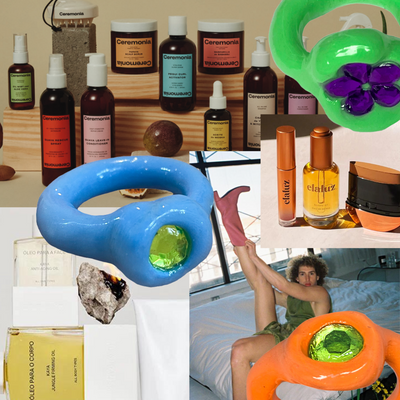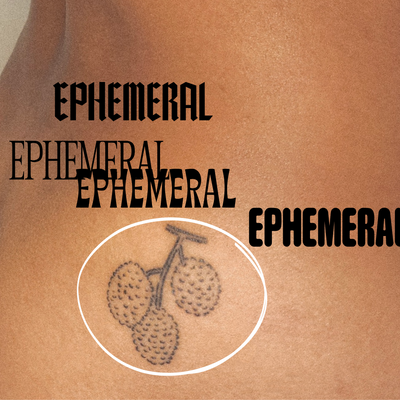I used to hate putting on moisturizer as a kid.
By kid I mean, like 12; the beginnings of puberty. Growing up when St.Ives and benzoyl peroxide was considered ‘skincare’ gave me the notion that anything ‘greasy’ (AKA moisturizing) would cause breakouts or just be plain uncomfortable and slippery. WOW, how far we have all come. Anyone who grew up in the 2000s knows the struggle and appreciates the glow up.
SEE ALSO: How to get rid of annoying back acne
I would often have these little bumps on the backside of my arms and my legs which were really bothersome. People would just say, “Oh, you should really exfoliate more,” but it never worked. I finally learned there was a term for it, keratosis pilaris. Or KP. As soon as I heard someone explain it, I freaked out. I thought, “This is normal?? someone else gets these bumps too?” I finally had someone to help me get to the bottom of this. Tell me all your secrets, I pleaded.
At the time, they flooded my brain with products I should look into and the way that I shower and moisturize. It all felt very science-y and I loved it. This KP revelation (seriously, it was) happened about four years ago. And while I’ve learned what KP is, that it’s completely normal, and some good products to use, I still don’t know enough. Plus, I know I can be doing a better job of treating it. I reached out to Dr. Caren Campbell, one of our go-to board-certified dermatologists for the KP lowdown. Read on for more, plus some VGL approved picks!
What is keratosis pilaris?
“[Keratosis pilaris describes the] rough, red, raised bumps on the backs of the upper arms and sometimes on thighs due to the plugging on the pore with a normal skin protein called keratin,” says Dr. Campbell.
KP bumps are not little pimples all over your body (don’t squeeze!) and they’re not a rash either! It’s very common in people and it isn’t painful, just rough to the touch, and can be frustrating at times.
Everyone’s body produces keratin. It’s actually an important protein for hair growth and strength, but sometimes it gets trapped in our pores and our body is like “Uhhh what do I do with this?” and that’s how KP happens. Dr. Campbell also told me KP is genetic, much like eczema.
Why does my KP get worse in the winter?
I feel almost every skin woe is worse in the winter. It’s just a thing…it’s cold and our skin gets irritated. I totally struggle with dryness and eczema and my KP is more prevalent due to redness. Does keratin really ramp up production when it’s cold?
Dr. Campbell notes that the real reason why it tends to flare up is because of clothing and dryness. In the colder months, we’re wearing many layers and our skin is always covered, which doesn’t always allow it to breathe. And of course, it’s so, so dry. We need all the moisture. Long-lasting moisture products are best in this case.
What are the best practices for keeping up with KP?
Dr. Campbell recommends avoiding any friction, rubbing, or irritating topical agents, as this will exacerbate the redness and appearance of the bumps.
For some patients, mild chemical exfoliators can help remove the excess keratin that is plugging the follicle opening. Amlactin applied daily after showering can help some patients, and glycolic acid contained in washes and lotion is another option to try if Amlactin doesn’t work for you. Urea lotions, retinoids diluted with creams like CeraVe, or anti-inflammatory creams like diclofenac can help some patients non-responsive to the above options.
VGL approved picks:
CVS Health Dry Skin Therapy Deep Repair Lotion ($10.49)
The trusty drugstore pick. This is what saved my KP back when I chatted with that friend and I still use it now! Besides providing great moisture for the dryest of KP and overall skin, it contains alpha-hydroxy which is key in sloughing off that dead skin and keratin buildup. This is also great if you have skin that sits on the more sensitive side and you don’t want to scrub. Your lotion will exfoliate for you!
The Body Shop Skin Sponge ($5.00)
Another cost-effective product that helps fight your KP bumps in between treatments! This sponge is actually made from recycled milk cartons and can be recycled again once you’re done with it. It’s truly a hidden gem sold at The Body Shop and while it feels a bit rough at first, it does soften up a bit. Lather a bunch of soap or body wash right on the sponge and give yourself the exfoliation of a lifetime. Replace after thre months of use. I exfoliate using this three times a week to keep my KP at bay.
CeraVe SA Body Lotion for Rough and Bumpy Skin with Salicylic Acid ($15.69)
Body lotion made for rough and bumpy skin? Just what KP needs. This CeraVe lotion has salicylic acid in it to help smooth and soften skin. It can also treat the occasional ingrown hair or pimple you may have. This product contains lactic acid for exfoliation, and it has ceramides to help repair and protect your skin barrier with deep moisture and much-needed vitamins.
Derma Doctor KP Duty 1o% AHA+PHA Scrub ($50)
This is a bit more pricey than previous drugstore options but it’s powerful and works quickly. KP Duty is a body scrub and it has 10% of PHA+AHA combined. It’s a cult favorite and I like it because it’s rich in linoleic acid (vitamin F) which helps repair your skin barrier. Follow up with a moisturizer and be sure to lather on the SPF if you have plans to soak up some sun after.
TLDR;
– Keratosis Pilaris can be a drag but it is 100% treatable
– It’s a buildup of keratin in your pores and causes rough, red bumps on arms and legs
– You can have the soft skin you’ve always dreamed of with a little help from products
– Look for something with chemical exfoliation and make sure to hydrate your skin with deep moisture products





